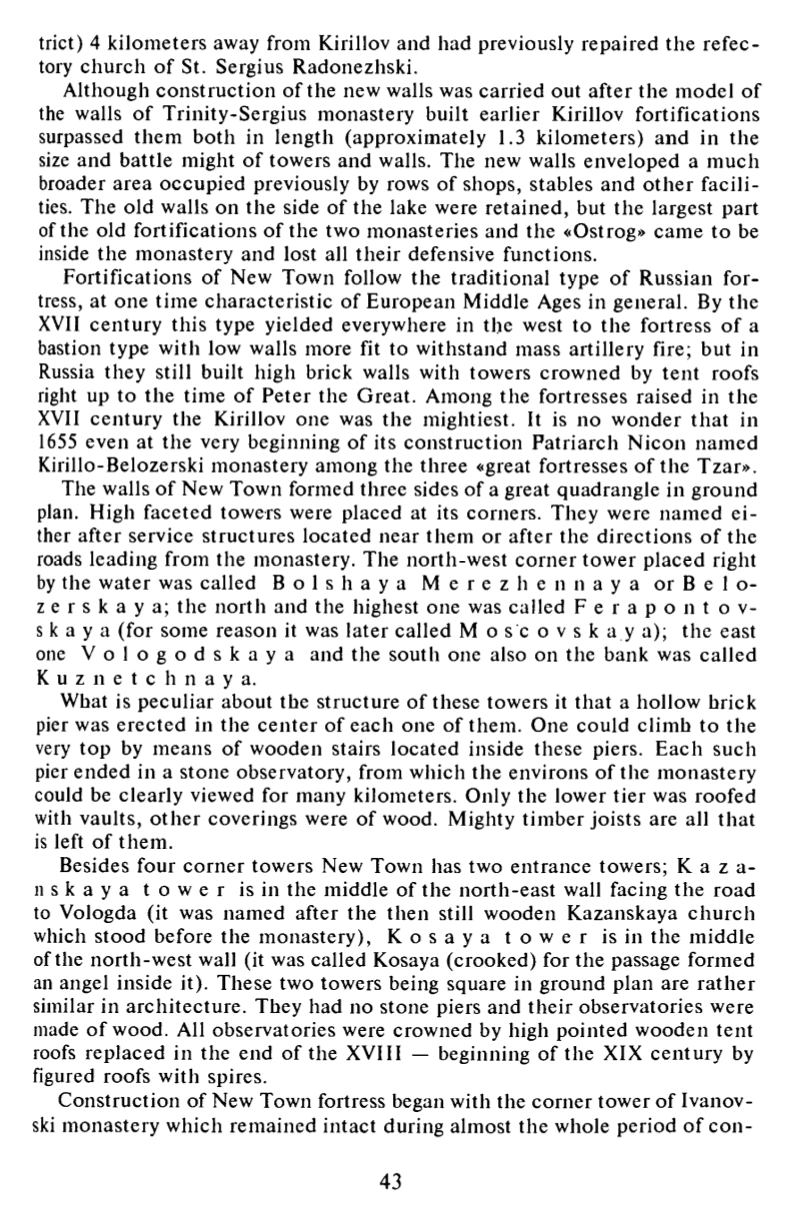

trict) 4 kilometers away from Kirillov and had previously repaired the re fec
tory church o f St. Sergius Radonezhski.
Although construction of the new walls was carried out after the model of
the walls o f Trinity-Sergius monastery built earlier Kirillov fortifications
surpassed them both in length (approximately 1.3 kilometers) and in the
size and battle might o f towers and walls. The new walls enveloped a much
broader area occupied previously by rows of shops, stables and o the r facili
ties. The old walls on the side of the lake were retained, but the largest part
of the old fortifications o f the two monasteries and the «Ostrog» came to be
inside the monastery and lost all their defensive functions.
Fortifications of New Town follow the traditional type o f Russian for
tress, at one time characteristic of European Middle Ages in general. By the
XVII cen tury this type yielded everywhere in the west to the fortress o f a
bastion type with low walls more fit to withstand mass artillery fire; but in
Russia they still built high brick walls with towers crowned by ten t roofs
right up to the time o f Peter the Great. Among the fortresses raised in the
XVII cen tury the Kirillov one was the mightiest. It is no wonder tha t in
1655 even at the very beginning of its construction Patriarch N icon named
Kirillo-Belozerski monastery among the three «great fortresses o f the Tzar».
The walls o f New Town formed three sides of a great quadrangle in ground
plan. High faceted towers were placed at its corners. They were named e i
ther after service structures located near them or after the directions o f the
roads leading from the monastery. The north-west corner tower placed right
by the water was called B o l s h a y a M e r e z h e n n a y a or B e l o
z e r s k a y a ; the north and the highest one was called F e r a p o n t o v -
s к a у a (for some reason it was later called M o s ' c o v s k a y a); the east
one V o l o g o d s k a y a and the south one also on the bank was called
K u z n e t c h n a y a.
What is peculiar about the structure o f these towers it that a hollow brick
pier was erected in the cen te r of each one of them. One could climb to the
very top by means of wooden stairs located inside these piers. Each such
pier ended in a stone observatory, from which the environs o f the monastery
could be clearly viewed for many kilometers. Only the lower tier was roofed
with vaults, o the r coverings were of wood. Mighty timber joists are all that
is left o f them.
Besides four corner towers New Town has two entrance towers; K a z a
n s k a y a t o w e r is in the middle of the north-east wall facing the road
to Vologda (it was named after the then still wooden Kazanskaya chu rch
which stood before the monastery), K o s a y a t o w e r is in the middle
of the north-west wall (it was called Kosaya (crooked) for the passage formed
an angel inside it). These two towers being square in ground plan are ra the r
similar in architecture. They had no stone piers and their observatories were
made o f wood. All observatories were crowned by high pointed wooden tent
roofs replaced in the end of the XVIII — beginning of the XIX cen tury by
figured roofs with spires.
Construction of New Town fortress began with the corner tower of Ivanov
ski monastery which remained intact during almost the whole period o f c o n
43















